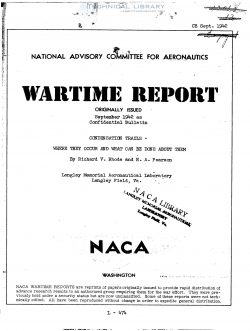naca-wr-l-474
- Version
- 114 Downloads
- 557.13 KB File Size
- 1 File Count
- April 2, 2017 Create Date
- April 2, 2017 Last Updated
Condensation Trails - Where they Occur and What Can Be Done About Them

By Richard 7. Rhode and H; n. Pearson
ronrwonn
A brief. nontechnical discussion of condensation
trails is presented for flying personnel. World maps
showing trail—forming zones at different altitudes and
seasons are presented Means for suppressing trails are
given. -
NaffiRE 0F COHDENSATIOH TRAILS
Condensation trails are of three types:
1. Exhaust trails — Formed by condensation of mois—
ture from the engine exhaust.
4. Convection trails — ?ormed under certain atmospheric
conditions as a result of rising of air warmed
by passage of the airplane.
3. Aerodynamic trails — Formed by precipitation of
atmospheric moisture as a result of adiabatic
temperature drop associated with' air flow past
the airplane.
The enumeration of three distinct types of candeneation
trails should not, of course, be construed to mean that
combinations,of these types are not possible.
Exhaust trails.— The exhaus t trail is- the most impor—
tant from military considerations. as it may be rather
consistently encountered at some altitudes and latitudes.
It is peculiar to high—altitude operations and is explained
as follows:
The hydrogen of the fuel used combines with oxygen
from the air and forms water. When normal aviation
gasoline is burned in an engine. about 1.25 pounds of
water is formed as vapor_and is discharged with the ex-
haust for each pound of fuel burned.
Behind the engine—carrying body (fuselage or nacelle)
a turbulent region or wake is formed as the airplane
flies. The exhaust moisture and some of the engine heat
are discharged into this wake and become diffused through—
out the wake as a result of the mixing action of the tur—
bulence. The moisture and heat do not, however, mix with
the air outside the wake because there the air is "smooth."
The vortices in the wake grow and rotate more slowly
as they pass downstream from the airplane. Thus the wake
expands and decays. During this process the energy of the
turbulence is dissipated as heat as a result of viscosity
or friction, and finally so much energy has been dissipated
that the wake can no longer continue to grow. This point
is reached at a mile or more behind the airplane. the'ex—
act distance being somewhat indefinite and dependent upon
the speed and power of the airplane. By this time, because
of the action of_wing—tip vortices, the wake has changed
in form from its original compact cross section to a more
or less flat ribbonlike form with curled—up edges, but this
change in form does not involve any further mixing of the
water vapor with the air.
It is easy to see that,'if the hir'ie.so hold that it
cannot hold much water as vapor, the water in the exhaust
may be sufficient. when added to the moisture already in
the atmosphere, to raise the humidity in the turbulent
wake to or beyond the saturation value. If this condition
exists, some of the water vapor will condense and a visible
trail will form.
Since the turbulent wake is narrow near the airplane,
the density of moisture will be greatest at this location.
Farther away, where the wake is larger and the exhaust
moisture is more widely diffused, there will be less mois-
ture density. Thus. under some conditions. a short trail
may form that evaporates w here the wake cross se'ction be-
comes too large to maintain loo-percent humidity. If the
amount of moisutre is great enough to more than saturate
the wake at its final and greatest cross section. however,
the trail will be persistent aid will not disappear until
it is finally blown away by the wind or dissipated by at—
mospheric turbulence.
From the foregoing explanation it is clear that ex-
haust trails are favored by
| File | Action |
|---|---|
| naca-wr-l-474 Condensation Trails - Where they Occur and What Can Be Done About Them.pdf | Download |

Comment On This Post